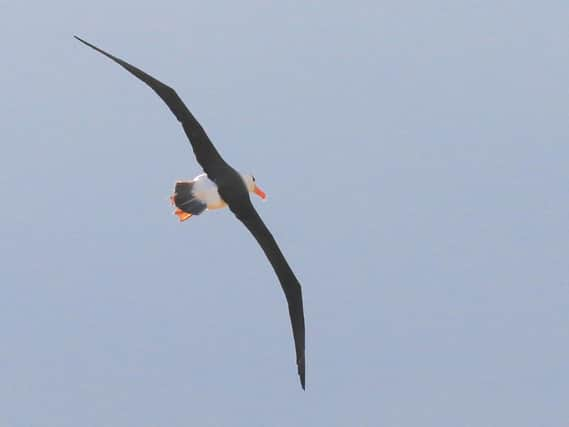Northern hemisphere's only albatross heads to Filey as hundreds of birdwatchers and Bill Oddie visit to see it on the Yorkshire coast


The comedian and presenter is rumoured to have been seen at the nature reserve near Bridlington attempting to spot the black-browed albatross which has now spent a week in the area.
The albatross is the only bird of its kind living in the northern hemisphere, having been blown off course several years ago and found itself unable to return to its breeding grounds in the South Atlantic.
Advertisement
Hide AdAdvertisement
Hide AdDubbed 'Europe's loneliest bird', it is unlikely to ever find a mate.
The huge seabird has delighted onlookers with regular appearances, mostly in the mornings, and numerous wildlife photographers have managed to capture images of it.
It is now thought to have flown towards Filey.
The RSPB said that Bempton Cliffs has been busier than normal, though the increase in visitor numbers is also attributed to the staycation boom. As well as Oddie, well-known birdwatcher and author Lee Evans is thought to have visited and facilities such as the toilets and car park have opened late into the evenings to accommodate the crowds.
Staff have welcomed visitors from as far afield as Plymouth, Brighton and Wales who had come to see the albatross.
Advertisement
Hide AdAdvertisement
Hide AdThe RSPB's Maria Prchlik said: "We’ve had people from far and wide visiting. I was on the reserve Sunday evening and the car park was still packed.
"t’s hard to put a figure on the folk who’ve come purely to see the albatross. But there’s been a definite increase in visitor numbers this year so far, in part due to the increased number of people holidaying in the UK. How much of this has been due to the albatross effect recently, we just can’t say.
"There was a suggestion that Bill Oddie had been to see the bird and we believe that Lee Evans has visited too."
The albatross was first seen in Europe in 2014. The lost wanderer was spotted at Bempton Cliffs in 2017, and visited again last summer. It survived an attack by white-tailed eagles in Denmark this spring which many birdwatchers feared had led to its death.
Advertisement
Hide AdAdvertisement
Hide AdThe black-browed albatross was lingering in Oresund, a narrow stretch of water between Copenhagen and Malmo, in April when up to nine eagles attacked it. It also managed to escape an eagle ambush in Denmark in 2015.
Only two 'lost' albatrosses have been recorded in Europe in the past decade, with the world's entire breeding population living in the South Atlantic. They have a northerly migratory pattern, which explains the occasional sightings in the North Atlantic. These displaced birds are considered 'vagrants' because they have wandered far outside their normal range. They are often exiled for decades as they struggle to return to the Southern Ocean.
Albatrosses are traditionally associated with sailors and the age of maritime exploration, when they were hunted extensively, although they were also viewed as totems by superstitious seafarers.